
Top-Earning Nonprofit Hospitals Provide Less Charity Care Than Low Earners Do
The highest-earning nonprofit hospitals in the United States provided less charity care to patients than lower-earning hospitals did, relative to the facilities’ respective profits, according to a new study from Johns Hopkins University.
For every $100 of net income, hospitals in the top-earning quartile gave $11.5 of charity care to uninsured patients and $5.1 to insured patients.
In contrast, hospitals in the lower, third quartile of income gave considerably more – $72.3 to the uninsured and $40.9 to the insured.
Hospitals in the top 1 percent of earnings generated 23 percent of the net income of all nonprofit hospitals and provided 7 percent (to the uninsured) and 5 percent (insured) of the charity care at all nonprofit hospitals.
The data came from 2017 Medicare cost reports published by the federal Centers for Medicare and Medicaid Services.
“The highest-earning hospitals have done very well financially,” says the study’s lead author, Associate Professor Ge Bai of the Johns Hopkins Carey Business School. "The top 1 percent made more than $10 billion profit, and the top 5 percent more than $25 billion. Yes, they take certain measures to help financially disadvantaged patients, but they’re positioned to do more.”
Published as a research letter in JAMA Internal Medicine, the study looks at data from 2,563 nonprofit short-term general hospitals. The 640 hospitals in the top-earning quartile generated nearly $48 billion in net income in 2017 – or slightly over 100 percent of all net income reported by the 2,563 facilities. The hospitals in the three lower quartiles reported negative net income in aggregation.
Bai and her co-authors – Professor Gerard Anderson and PhD candidate Farah Yehia, both of the Johns Hopkins Bloomberg School of Public Health – say their research breaks new ground by distinguishing between charity care for uninsured patients and insured patients, and by exploring charity care across hospitals’ financial status.
“Congress and state legislatures need to take a careful look at the proper balance between the hospitals’ profits and their level of charity care. Too many very profitable nonprofit hospitals are providing little charity care,” says Anderson.
Nonprofit hospitals must offer charity care and other community services as a condition of their exemption from income, property, and sales taxes. The facilities provide charity care to eligible uninsured and insured patients, with no expectation of payment.
The study also found that in states where Medicaid was expanded under the Affordable Care Act, hospitals gave less charity care than hospitals in other states did – $12 versus $37.8 for uninsured patients, and $8.7 versus $11 for insured patients, measured against every $100 of net income.
“Nonprofit hospitals have full discretion in designing their financial assistance policy,” says Bai. “The top-earning hospitals, which have substantial financial strength, should design more generous eligibility criteria to help uninsured and underinsured patients. The hospitals’ nonprofit status and tax exemptions require such action.”


